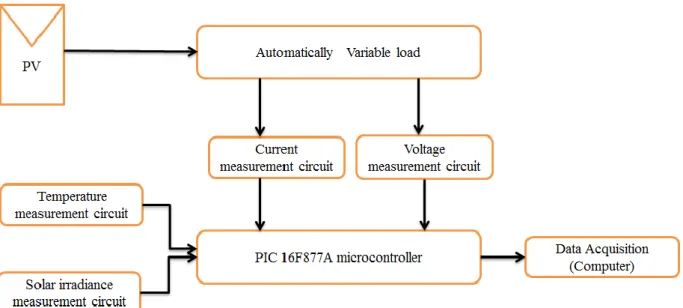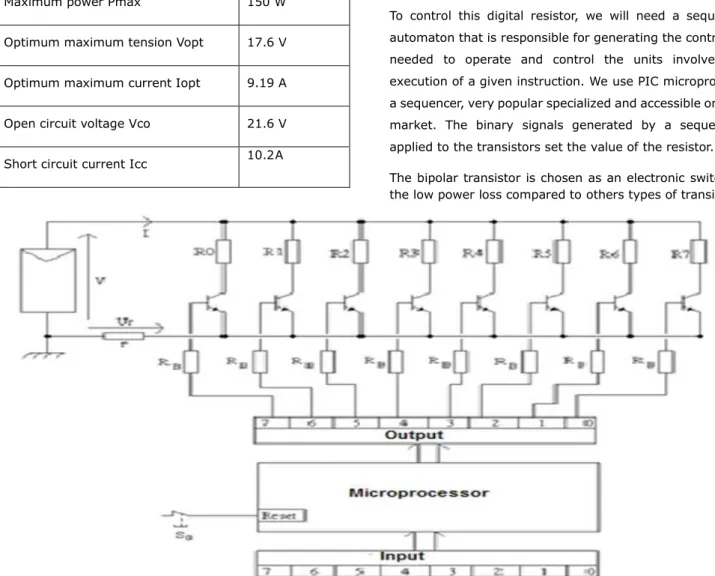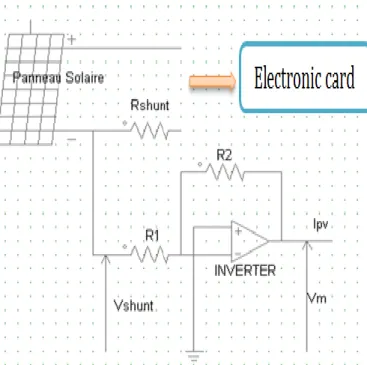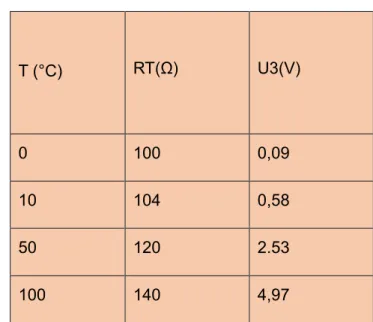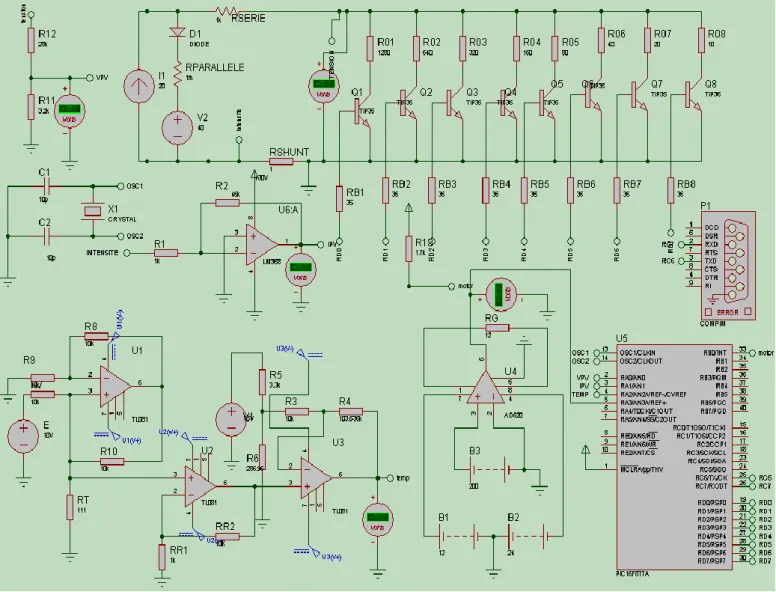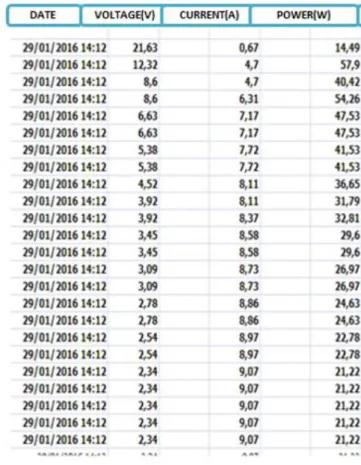HAL Id: hal-02151271
https://hal.archives-ouvertes.fr/hal-02151271
Submitted on 7 Jun 2019
HAL is a multi-disciplinary open access
archive for the deposit and dissemination of
sci-entific research documents, whether they are
pub-lished or not. The documents may come from
teaching and research institutions in France or
L’archive ouverte pluridisciplinaire HAL, est
destinée au dépôt et à la diffusion de documents
scientifiques de niveau recherche, publiés ou non,
émanant des établissements d’enseignement et de
recherche français ou étrangers, des laboratoires
solar module characteristics data acquisition system
Modelling and simulation of an automatic solar module
characteristics data acquisition system
E Akoro, G Tevi, M. Faye, M. Sene, A. Maiga
To cite this version:
E Akoro, G Tevi, M. Faye, M. Sene, A. Maiga. E.Akoro et al -Modelling and simulation of an automatic
solar module characteristics data acquisition system Modelling and simulation of an automatic solar
module characteristics data acquisition system. Materials and Devices, Collaborating Academics –
International Press, 2019, 4, �10.23647/ca.md20191602�. �hal-02151271�
Article type: T-Technical paper
Modelling and simulation of an automatic solar
module characteristics data acquisition system
E.Akoro, G. J. P. Tevi, M. E. Faye, M. Sene and A. S. Maiga
Laboratoire d'Electronique, Informatique, Télécommunication et Energies Renouvelables, UFR des Sciences Appliquées et des technologies, Université Gaston Berger-Saint-Louis, Sénégal
Corresponding author: justinakoro@gmail.com
RECEIVED: 20 november 2018 / RECEIVED IN FINAL FORM: 15 february 2019 / ACCEPTED: 16 february 2019 Abstract: This paper is devoted to the design and simulation of an automatic data acquisition system of solar module characteristics. The system is essentially composed of three parts. The first part is devoted to the acquisition of the electrical parameters of the solar module (Current, Voltage and Power) in automatic ways using an automatic variable load. The second part is focused on devices which measure the ambient temperature and solar irradiation. In the last part, we study the design of an acquisition interface and a database for data saving. The results of simulations validate the correct operation of the measuring bench.
Keywords: PV MODULE, AUTOMATICALLY VARIABLE LOAD, ACQUISITION INTERFACE, DATABASE
Introduction
The performance of photovoltaic modules is based on a number of significant parameters extracted from the characteristic I-V such as the short-circuit current Isc, the open-circuit voltage Voc, the current Impp, and the voltage Vmpp at the point of maximum power, the form factor FF, the series resistance Rs and the shunt resistance Rsh [1]. On the other hand, the atmospheric parameters in which the solar module must operate are generally not taken into account by the manufacturers. These climatic parameters often change abruptly, which can affect the efficiency of photovoltaic
systems [2]. Thus, to study their influence on the operation of the solar module, it would be interesting to have a database in which various data (PV Current, voltage and Power, Temperature and irradiance) will be permanently recorded for their exploitation.
This work consists in designing a device for automatic acquisition of the characteristics of solar modules and climatic parameters.
To have the characteristic of the current (I) as a function of the voltage (V), we opted for an automatic variation of the load at the terminals of the PV module which is an 8-bit R / 2R digital-to-analog converter (DAC). The climatic parameters taken into
Cite this article:
E.Akoro, G. J. P. Tevi, M. E.
Faye, M. Sene and A. S. Maiga, OAJ Materials
and Devices, Vol 4 (1), 1602 (2019) – DOI:
account are the temperature and solar irradiation. The acquisition of all these parameters is done in automatic ways controlled by a microcontroller which name is PIC16f877. The overall scheme of the simulated electronic card is design under the ISIS PROTEUS software.
Synoptic diagram of the system
As we pointed out in the introduction, the purpose of this work is to have a database in which data will be permanently recorded. This is the result of an automatic device set to acquire all these data. To realize this automatic system of acquisition, it is necessary to involve a certain number of elements:
The solar module: which is a technological device intended to convert solar radiation into electrical energy.
Automatically Variable load: current and voltage values measurement requires a variable load that will vary the voltage and the current at the terminals of the solar module, which will be used for plots of different characteristic curves.
Sensors: to measure the climatic parameters.
Acquisition card: responsible for collecting all these parameters that we want to record in the database.
Computer: After acquisition and appropriate conversions of data by the acquisition card, it is necessary to route them to a computer (Computer) via a RS232 serial link for operation and possibly storage.
The figure below illustrates the synoptic diagram of the system
Figure 1: Synoptic diagram of the automatic acquisition system
Effects of Climatic parameters on
solar cells
Climatic parameters such as temperature and irradiation have a considerable influence on the characteristics of a solar module. Increasing the temperature with fixed irradiation results in a net decrease of the open circuit voltage (Voc) and an increase of the short circuit current (Icc), as well as a decrease in the maximum power (Pmax). Similarly, when the irradiation varies for a temperature kept constant at 25 ° C, the short-circuit current (Icc) varies due to the irradiation, whereas the open-circuit voltage (Vco) varies very little [3].
Measurement of electrical
parameters
Equivalent Circuit of Solar Module
In the absence of a solar module model under the ISIS software that we used, we designed a simpler diode module model by paralleling a current and voltage generator. Using a voltmeter and an ammeter, we made sure to obtain the critical values of our photovoltaic generator, namely, the maximum short-circuit current Icc and the maximum open-circuit voltage Voc.
Figure 2: one-diode module model
Our study will focus on the monocrystalline SP75 with the following features:
Table 1: Characteristics of the single-crystal SP75 panel
Automatically variable load
For the automatically variable load, we use an 8-bit R / 2R (Figure 3) digital-to-analog converter (DAC) developed in [4].It is a resistance network composed of only two values, R and 2R. The role of this load is to automatically vary the impedance at the terminals of the photovoltaic generator (GPV) to allow measurement of the current and voltage of the module. With this load R / 2R network, we can obtain 256 measurements of current-voltage torque (I-V).
To control this digital resistor, we will need a sequencer, an automaton that is responsible for generating the control signals needed to operate and control the units involved in the execution of a given instruction. We use PIC microprocessor as a sequencer, very popular specialized and accessible on the local market. The binary signals generated by a sequencer and applied to the transistors set the value of the resistor.
The bipolar transistor is chosen as an electronic switch due to the low power loss compared to others types of transistors.
Figure 3: Programmable control of the automatically variable load. Voltage measure
Maximum power Pmax 150 W
Optimum maximum tension Vopt 17.6 V Optimum maximum current Iopt 9.19 A Open circuit voltage Vco 21.6 V Short circuit current Icc 10.2 A
We use a voltage divider bridge to measure the voltage. It is made by two resistors placed between the output of the solar panels and the ground. Figure 4 allows to go from the voltage Vpv at the outputs of the photovoltaic module to the voltage Vpm range in 0 and 5 volts, to be then measured by the microcontroller.
The relation expressing the voltage Vpv as a function Vpm is:
𝑉
𝑝𝑚=
𝑉𝑝𝑣.𝑅11𝑅11+𝑅12
(1)
Figure 4: Diagram of voltage measurement
Current measurement
For current measurement (Figure 5) the simplest method is to measure the voltage across a resistor to derive the current flowing through it. This method is not expensive compared to other techniques and provides good accuracy in low frequency. The measuring resistor and the circuit associated with it must have good temperature stability and good accuracy [5].
As for the voltage measurement circuit, this voltage obtained at the output of this amplifier must be between 0 and 5 volts and thus be measurable by the microcontroller. The Ipv current of the photovoltaic generator is:
Ipv =
VshuntRshunt
(2)
The relationship between the measured voltage (Vm) and the shunt voltage (Vshunt) is:
𝑉𝑚 = −
𝑅2𝑅1
. 𝑉𝑠ℎ𝑢𝑛𝑡 (3)
R1 and R2 must be chosen so that Vm is between 0 and 5 v.
Figure 5: Current measurement circuit
Measurement of climatic parameters
As described above the characteristics of a photovoltaic panel are influenced by several climatic parameters that must be controlled, namely the temperature of the panel and the solar irradiance. If one or the other of these quantities varies too much during the successive measurements corresponding to a curve, then the results will not be relevant, hence the need to characterize these different parameters.
Temperature measurement
We use the RTD Pt100 temperature sensor described in [6] to measure the temperature. It is a resistance which value changes as a function of the evolution of the temperature (At 0 ° C the value of the resistor is 100 ohm).
The theoretical value of the resistance for a Pt100 probe is: RT = 100 (1 + 0,004) (4)
With the temperature. To adapt the signal from the platinum resistance to the microcontroller input, it is necessary to use a conditioner
.
+ _ M R R R E R + _ RT générateur de courant -+ U 2 R1 R2 AOP 1 AOP 2 AOP 3 deuxième étage U 1 U 3 +15V R 4 R3 R5 R6 troisième étage premier étage U P
Figure 6: Conditioning circuit for the Pt100 sensor The whole consists of a first current generator level is followed by a second amplifier level. The third level allows to obtain a linear response U3 = k.
The current generating circuit enables the platinum resistance to be fed with a current of constant intensity
I =
ER
= 1 mA
(5)The voltage across the platinum resistance is, therefore, an affine function of the temperature:
𝑈1 = 𝑎 + 𝑏 (6)
The second level amplifier allows to amplify the U2
voltage 1 1 2 2
R
R
1
U
U
(7) The last level eliminates the constant term from the voltage divider (UP) and adjusts the yield
with resistor R4 to have a direct reading of the
temperature:
P 3 4 2 3 4 3
R
R
R
R
1
U
U
U
(8) By choosing: E = 10 V; R = 10 k ; R1 = 1 k ; R2 = 10 k ; R3 = 10 k ;
R5 = 3.3 k and playing on the result to be obtained which
should be U3=0.05 so as to have 0°C U3=0V and at 100°C
U3=5V, we get by calculation R4 = 103.636k and
R6=286.96.
Operational amplifiers (TL081) are supplied with + 15V / -15V.
The simulation of this conditional circuit gives the following results:
Table 2: Simulation Results of the Conditioning Circuit for the Pt100 Sensor
Solar irradiance measurement
To measure the global solar radiation at the surface of the photovoltaic modules, we use the Kipp & Zonen CMP11 pyranometer, with a sensitivity of 8.44 μV/W.m.
As the temperature, to adapt the output signal of the pyrometer to the input of the microcontroller, it is necessary to use a conditioner described in [7].
The irradiance measuring circuit is as follows:
Figure 7: Conditioning circuit for the Kipp & Zonen CMP11 sensor
The relations leading the operation of this circuit are given in the following:
V
Em= GxV
E(9)
𝐺 = 1 +
49,4𝐾 𝑅𝐺(10)
V
E= SxE (11)
T (°C)
RT(Ω)
U3(V)
0
100
0,09
10
104
0,58
50
120
2.53
100
140
4,97
First level Second level Third levelThus, the irradiance E is defined as a function of the output voltage of the amplifier by the following relation:
𝐸 =
VEm8,44.10−6(1+49,4K RG )
(12)
To test the operation of the conditioning circuit, the latter has been simulated with Isis Proteus.
E (W/m2 ) 0 100 40 0 600 900 100 0 120 0 VEM(V) 0 0.4 5 1.7 2.5 3 3.7 9 4.21 4.7
Table 3: Results of simulation of the conditioning circuit for Kipp & Zonen CMP11
Design of the electronic card
The electronic card which control the acquisition of the various parameters is captured and simulated under the Isis proteus software.
In addition to the sensors and the automatic variable load, the electronic card contains the following elements: Microcontroller PIC 16F877A, Quartz oscillator delivering a periodic signal which runs the steps of the microcontroller program, the RS232 link used to transmit information from the microcontroller to the acquisition interface without using the synchronization clock. The figure below shows the simulated electronic card under ISIS:
Acquisition interface and Recording of
data
The interface we designed is used to read the data received from the RS232 serial link. We used the Visual Studio Express 2012 software developed by Microsoft Corporation.
The read data are: Temperature (°C), solar irradiance (W/m²), current (A), voltage (V) and power (W) of the photovoltaic module.
When the electronic card is powered, just choose port 2, click the Start button to start playback. After 256 read values the loop resumes. The end of the acquisition will be decided by the managers of the laboratory.
The figure below shows the acquisition interface in operation:
Figure 9: The system of acquisition in full operation
In order to better analyze the data read on the interface, a database is created for the recording. This database is nothing more than a file in which a line of data is written every second and recorded automatically. Each line is associated with a date, the year, the month, the day, the hour, the minute and the second.
The following figure shows the file containing the recorded data for a temperature of about 31 ° C and a solar irradiation of 1000 W / m².
Figure 10: Data record file (temperature = 31 °and Irradiance=1000 W/m2)
Conclusion
The work presented in this article deals with the automatic acquisition of the characteristics of solar modules. As part of the optimization of photovoltaic installations, our main objective was to set up a system that would facilitate the acquisition of the different characteristics of solar modules and then to save them in a database.
The results obtained are acceptable for the automatic acquisition of the characteristics of the solar modules. Data acquisition can be performed for all variables in a time range as small as one second which allows controlling the operation of the photovoltaic generator in real time.
Complementary informations on authors:
Edjadessamam AKORO: justinakoro@gmail.com, https://www.researchgate.net/profile/Edjadessamam_Akoro
Jean G.P. TEVI: tevi.gabriel-jean-philippe@ugb.edu.sn, https://www.researchgate.net/profile/Tevi_Gabriel_Jean-Philippe
Marie E.Faye DIAGNE: Marie-emilienne.faye@ugb.edu.sn,
https://www.researchgate.net/scientific-contributions/2146975088_Marie_Emilienne_FAYE
Moustapha SENE: mstsene@yahoo.fr,
https://www.researchgate.net/scientific-contributions/2146960350_Moustapha_SENE
Amadou S. MAIGA: amadouseidou.maiga@ugb.edu.sn,https://www.researchgate.net/profile/SEIDOU_MAIGA_Amadou
REFERENCES1. E.Durán, J.M. Andújar; Galán, M.Sidrach-De-Cardona, Methodology and experimental system for measuring and displaying I-V characteristic curves of PV facilities. Prog. Photovolt. Res. Appl. 2009.
2.
C.J. Lohmeier (2011), Highly Efficient Maximum Power Point Tracking Using a Quasi-Double-Boost DC/DC Converter for Photovoltaic Systems. University of Nebraska – Lincoln, Electrical & Computer Engineering, Department of Computer Engineering3. Fatou NDIAYE, Moustapha SENE, ModouBEYE, Amadou S. H. MAIGA, Effects of climatic conditions on a polycrystalline photovoltaicmodule inNiger.International Letters of Chemistry, Physics and Astronomy,ISSN: 2299-3843, Vol. 55, pp 59-65
4.
O.Sow, D.Diarisso, N.MBodji, M.Diallo, A.Diao, I.Gaye,F.I.Barro, G.Sissoko (2016), Experimental Processus for Acquisition Automatic Features of I-V Properties and Temperature of the Solar Panel by Changing the Operating Point. Circuits and Systems, 7, 3984-4000.5. L.Yang, and A.Yang, Communication—On Zero-Resistance Ammeter and Zero-Voltage Ammeter.Journal of The Electrochemical Society, 164 (13) C819-C821 (2017)
6. Généralité sur les sondes PT100 [in line]. [viewed on June 12, 2019]. lipsakiss.free.fr/anal/ING2/CAO_elec/Projet/PT100.doc
7. A. Triki, A. Mahrane, A. Guenounou et M. Laghrouche, Conception et simulation d’un banc de mesure de la caractéristique I - V des modules photovoltaïques,Revue des Energies Renouvelables Vol. 17 N°1 (2014) 29 – 41
Important: Articles are published under the responsability of authors, in particular concerning the respect of copyrights. Readers are aware that the contents of published articles may involve hazardous experiments if reproduced; the reproduction of experimental procedures described in articles is under the responsability of readers and their own analysis of potential danger.
Reprint freely distributable – Open access article
Materials and Devices is an Open Access journal which publishes original, and peer-reviewed papers accessible only via internet, freely for all. Your published article can be freely downloaded, and self archiving of your paper is allowed and encouraged!
We apply « the principles of transparency and best practice in scholarly publishing » as defined by the Committee on Publication Ethics (COPE), the Directory of Open Access Journals (DOAJ), and the Open Access Scholarly Publishers Organization (OASPA). The journal has thus been worked out in such a way as complying with the requirements issued by OASPA and DOAJ in order to apply to these organizations soon. Copyright on any article in Materials and Devices is retained by the author(s) under the Creative Commons
(Attribution-NonCommercial-NoDerivatives 4.0 International (CC BY-NC-ND 4.0)), which is favourable to authors.
Aims and Scope of the journal : the topics covered by the journal are wide, Materials and Devices aims at publishing papers on all aspects
related to materials (including experimental techniques and methods), and devices in a wide sense provided they integrate specific materials. Works in relation with sustainable development are welcome. The journal publishes several types of papers : A: regular papers, L : short papers, R : review papers, T : technical papers, Ur : Unexpected and « negative » results, Conf: conference papers.
(see details in the site of the journal: http://materialsanddevices.co-ac.com)
We want to maintain Materials and Devices Open Access and free of charge thanks to volunteerism, the journal is managed by scientists for science! You are welcome if you desire to join the team!
Advertising in our pages helps us! Companies selling scientific equipments and technologies are particularly relevant for ads in several places
